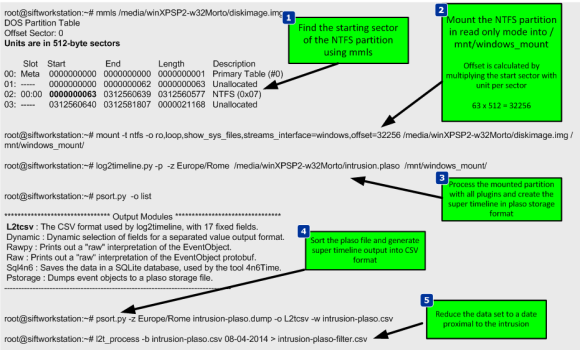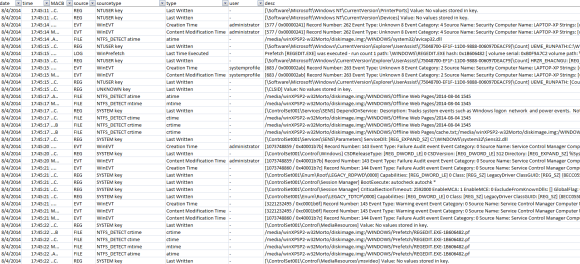After evidence acquisition, you normally start your forensics analysis and investigation by doing a timeline analysis. This is a crucial step and very useful because it includes information on when files were modified, accessed, changed and created in a human readable format, known as MAC time evidence. This activity helps finding the particular time an event took place and in which order. The traditional timeline analysis is done to the file system and has been used for several years and folks like Rob Lee and others have been championing it for years. The data is gathered using a variety of tools and is extracted from the metadata layer of the file system (inode on Linux or MFT records on Windows) and then parsed and sorted in order to be analyzed. The end goal is to generate a snapshot of the activity done in the system including its date, the artifact involved, action and source. The creation is an easy process but the interpretation is hard. During the interpretation it helps to be meticulous and patience and it facilitates if you have comprehensive file systems and operating system artifacts knowledge. To accomplish this step several commercial or open source tools exists such as the SANS Investigate Forensic Toolkit (SIFT) that is freely available and frequently updated.
In June 2010, the SANS reading room published a paper from Kristinn Gudjonsson as part of his GCFA gold certification introducing a new method called super timeline and a tool called log2timeline. The super timeline goes beyond the traditional file system timeline creation based on metadata extracted from acquired images by extending it with more sources of data in an automated fashion. As stated on Kristinn paper the super timeline includes more artifacts that provide vital information to the investigation. Basically the super timeline is a timeline of timelines that are gathered from the file system, registry keys and windows artifacts producing a single correlated timeline. To create the super timeline, Kristinn originally developed a framework that is materialized in the log2timeline tool written in Perl. The tool uses a modular approach that makes easier for someone to contribute to the project by developing a new module. A new module could be for example a new parser for a specific windows artifact. The first release introduced several parsers for windows artifacts such as the ability to create time stamped data of Chrome, Firefox, Opera and Internet Explorer browser history, Mcafee Antivirus log file, Open XML used in the Microsoft Office documents metadata, PDF metadata, pcap network captures, UserAssist registry key and others. The log2timeline has been actively developed by Kristinn and others and its backend is currently being replaced by a new framework named Plaso that still contains the log2timeline tool as a frontend and other many other tools written in Python.
In order to practice the production of a super timeline I created a realistic scenario that consists of a Windows XP system that has been compromised by w32/Morto worm just by having remote desktop service exposed to the internet with poor administrator password. Moments after being compromised the machine was taken offline and a forensic image bit-by-bit was created. The image was then moved to the SIFT workstation for analysis.
5 steps are needed to create the super timeline using the SIFT workstation and the logt2timeline.py front-end tool from the plaso suite.
Now with the evidence sorted and reduced I can start doing my analysis, investigation and looks for signs of Evil using for example Excel. An piece of the super timeline is showed in the following picture.
The creation of a super timeline is an easy process and it applies to different windows operating systems but the interpretation is hard. During the interpretation it helps to be meticulous and patience and it facilitates if you have comprehensive file systems, operating system artifacts and registry knowledge. With these type of methodology one can practice and improve their ability to determine past actions which have taken place and understand all kinds of artifacts which occur within the super timeline. On the SANS website there is another great article on how to create a super timeline with log2timeline. Here you can also view a 2011 webcast that looks at what is and how to do super timeline analysis. These and other steps to create a super timeline are well detailed in the log2timeline cheat sheet created by David Nides. The analysis and investigation will be part of other post.



[…] ترجمة : لمقال FORENSICS EVIDENCE PROCESSING – SUPER TIMELINE […]
LikeLike